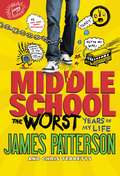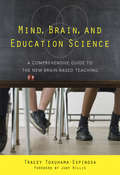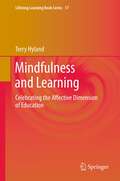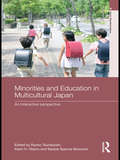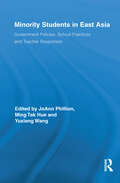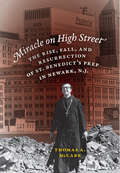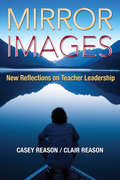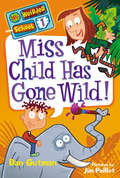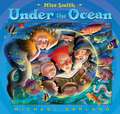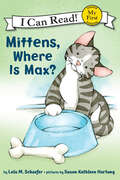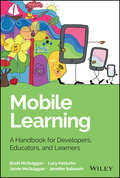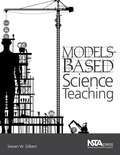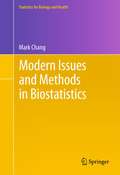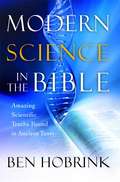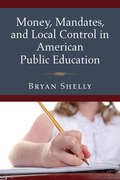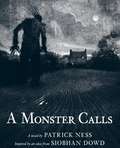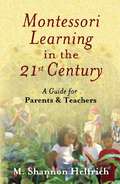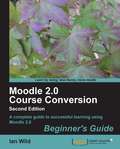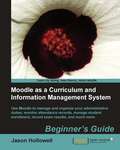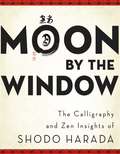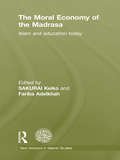- Table View
- List View
Middle School, The Worst Years of My Life: The Worst Years of My Life (Middle School #1)
by James Patterson Chris TebbettsDON&’T MISS THE BOOK BEHIND THE MAJOR MOTION PICTURE!In the hilarious and awkward start to this #1 mega-bestselling series, beloved misfit Rafe Khatchadorian takes on his first year of middle school…by breaking all the rules! Rafe Khatchadorian has enough problems at home without throwing his first year of middle school into the mix. Luckily, he's got a foolproof plan for the best year ever, if only he can pull it off: With his best friend Leonardo the Silent awarding him points, Rafe will break every rule in his school's oppressive Code of Conduct. Chewing gum in class--5,000 points! Running in the hallway--10,000 points! Pulling the fire alarm--50,000 points! But when Rafe's game starts to catch up with him, he'll have to decide if winning is all that matters, or if he's finally ready to face the rules, bullies, and truths he's been avoiding. #1 bestselling author James Patterson's debut middle-grade novel addresses some of middle schoolers' biggest issues: bullies, first crushes, and finding out what makes each of us special, all with a hilarious main character and fantastic in-text illustrations that are sure to have young readers begging for more!
Militant Publics in India
by Arafaat A. ValianiAn historically informed ethnographic study of conceptions, arenas, and practices of physical training and militancy in the context of religious nationalism intwentieth-and twenty-first-century western India. Arafaat A. Valiani offers readers a telling glimpse and a rare insider perspective of the social world in which militants are made, explaining how group physical training and technico-ethical experimentswith ithave created a powerful religious nationalist movement in the Indian state of Gujarat that has been held responsible for carrying outmassive episodes of ethnic cleansing against Indian minorities. Aclose reading of Mohandas Gandhi's writing on popular mobilization and resistance and a detailed historical investigation of hitherto understudied episodes of "satyagraha" (Gandhi's celebrated concept of non-violence), this work illuminates debates on politics in South Asian history, anthropology, and sociology. Valiani interprets his own direct observation of Hindu nationalist pogroms in contemporary Gujarat, in addition to testimonies and ethnographic observations of the inner workings of the movement discovered by the author when he immersed himselfas a "trainee" within it. "
Mind, Brain, and Education Science: A Comprehensive Guide to the New Brain-Based Teaching
by Tracey Tokuhama-EspinosaEstablishing the parameters and goals of the new field of mind, brain, and education science. A groundbreaking work, Mind, Brain, and Education Science explains the new transdisciplinary academic field that has grown out of the intersection of neuroscience, education, and psychology. The trend in "brain-based teaching" has been growing for the past twenty years and has exploded in the past five to become the most authoritative pedagogy for best learning results. Aimed at teachers, teacher trainers and policy makers, and anyone interested in the future of education in America and beyond, Mind, Brain, and Education Science responds to the clamor for help in identifying what information could and should apply in classrooms with confidence, and what information is simply commercial hype. Combining an exhaustive review of the literature, as well as interviews with over twenty thought leaders in the field from six different countries, this book describes the birth and future of this new and groundbreaking discipline. Mind, Brain, and Education Science looks at the foundations, standards, and history of the field, outlining the ways that new information should be judged. Well-established information is elegantly separated from "neuromyths" to help teachers split the wheat from the chaff in classroom planning, instruction and teaching methodology.
Mindfulness and Learning: Celebrating the Affective Dimension of Education
by Terry HylandIn recent decades, education at all levels has been seriously impoverished by a growing obsession with standards, targets, skills and competences. According to this model, only a circumscribed range of basic cognitive skills and competences are the business of education, whose main role is to provide employability credentials for people competing for jobs in the global economy. The result is a one-dimensional, economistic and bleakly utilitarian conception of the educational task. In Mindfulness and Learning: Celebrating the Affective Dimension of Education, Terry Hyland advances the thesis that education stands in need of a rejuvenation of its affective function - the impact it has on the emotional, social, moral and personal development of learners. Drawing on the Buddhist conception of mindfulness, he advances a powerful argument for redressing this imbalance by enhancing the affective domain of learning. Mindfulness and Learning: Celebrating the Affective Dimension of Education shows how the concept and practice of 'mindfulness' - non-judgmental, present moment awareness and experience - can enrich learning at all levels. Mindfulness thus contributes to the enhanced achievement of general educational goals, and helps remedy the gross deficiency of the affective/emotional aspects of contemporary theory and practice. The author outlines a mindfulness-based affective education (MBAE) programme and shows how it might be introduced into educational provision from the early years to adult education with a view to harmonising the cognitive-affective balance across the system.
Minorities and Education in Multicultural Japan: An Interactive Perspective (Asia's Transformations)
by Ryoko TsuneyoshiThis volume examines how Japan’s increasingly multicultural population has impacted on the lives of minority children and their peers at school, and how schools are responding to this trend in terms of providing minority children with opportunities and preparing them for the adult society. The contributors focus on interactions between individuals and among groups representing diverse cultural backgrounds, and explore how such interactions are changing the landscape of education in increasingly multicultural Japan. Drawing on detailed micro-level studies of schooling, the chapters reveal the ways in which these individuals and groups (long-existing minority groups, newcomers, and the ‘mainstream Japanese’) interact, and the significant consequences of such interactions on learning at school and the system of education as a whole. While the educational achievement of children of varying minority groups continues to reflect their places in the social hierarchy, the boundaries of individual and group categories are negotiated by mutual interactions and remain fluid and situational. Minorities and Education in Multicultural Japan provides important insights into bottom-up policy making processes and consciously brings together English and Japanese scholarship. As such, it will be an important resource for those interested in education and minority issues in Japan.
Minority Students in East Asia: Government Policies, School Practices and Teacher Responses (Routledge Series on Schools and Schooling in Asia)
by JoAnn Phillion Yuxiang Wang Ming Tak HueIn Minority Students in East Asia: Government Policies, School Practices and Teacher Responses authors discuss their research on minority students’ schooling (elementary to higher education) in Mainland China, Hong Kong, Japan, South Korea, and Taiwan. Minority students’ educational issues are often neglected in literature and in practice; social and educational conditions that have resulted from globalization – in particular issues pertaining to minority groups’ education, language and other human rights – receive little attention. In addition, many areas of East Asia have viewed themselves as single-ethnicity countries and have not articulated strong agendas around minority rights. The purpose of this book is to highlight key educational issues for specific minority populations in East Asia. Themes addressed include government policies related to minorities; equity issues in the education of minorities; school practices and teacher perspectives on minorities; identity construction in terms of language and culture; national versus ethnic identity; teacher education issues; and parental concerns. The authors also discuss new theoretical orientations to understanding minority educational issues. A particular strength of this book is the use of multicultural education theories to both articulate concerns related to the education of minority students and to provide solutions to these concerns.
Miracle on High Street: The Rise, Fall and Resurrection of St. Benedict's Prep in Newark, N.J.
by Thomas A. MccabeJust outside downtown Newark, New Jersey, sits an abbey and school. For more than 150 years Benedictine monks have lived, worked, and prayed on High Street, a once-grand thoroughfare that became Newark's Skid Row and a focal point of the 1967 riots. St. Benedict's today has become a model of a successful inner-city school, with 95 percent of its graduates--mainly African American and Latino boys--going on to college. Miracle on High Streetis the story of how the monks of St. Benedict's transformed their venerable yet outdated school to become a thriving part of the community that helped save a faltering city. In the 1960s, after a trinity of woes--massive deindustrialization, high-speed suburbanization, and racial violence--caused an exodus from Newark, St. Benedict's struggled to remain open. Enrollment in general dwindled, and fewer students enrolled from the surrounding community. The monks watched the violence of the 1967 riots from the school's rooftop along High Street. In the riot's aftermath more families fled what some called "the worst city in America. "The school closed in 1972, in what seemed to be just another funeral for an urban Catholic school. A few monks, inspired by the Benedictine virtues of stability and adaptability, reopened St. Benedict's only one year later with a bare-bones staff . Their new mission was to bring to young African American and Latino males the same opportunities that German and Irish immigrants had had 150 years before. More than thirty years later, St. Benedict's is one of the most unusual schools in the country. Its remarkable success shows that American education can bridge the achievement gap between white and black, as well as that between rich and poor. The story of St. Benedict's is about an institution's rise and fall, resurrection and renaissance. It also provides valuable insights into American religious, immigration, educational, and metropolitan history. By staying true to their historical values amid a continually changing city, the downtown monks, in resurrecting its prep school, helped save an American city. Some have even called it the miracle on High Street.
Mirror Images: New Reflections on Teacher Leadership
by Casey S. Reason Clair M. ReasonReflections on the new teacher leaders Mirror Images takes a comprehensive look at what teacher leadership means today and how teachers can transform the future of their profession. Included are ten iconic images of teacher leadership roles to help teachers move beyond teaching as they were taught. The authors make a compelling case for the importance of teacher leadership today based on these current conditions: Top-down change is less effective today than ever, Teacher leadership in schools is a force, not a position, Old stereotypes of teaching keep teachers from striving for more, Leadership, learning, and change are united.
Miss Child Has Gone Wild! (My Weirder School #1)
by Dan Gutman Jim PaillotMy Weirder School weirder than ever! <P><P>The third grade has won a weird contest, so they get to go on a field trip to the zoo. That's how they meet Miss Child, the weirdest zookeeper in the history of the world. She thinks animals are smarter than people! She thinks elephants can paint pictures! She keeps snakes in her pockets for fun! Guess who's going to wind up in a cage with a lion?
Miss Smith Under the Ocean
by Michael GarlandMiss Smith's class can't wait for story time. When their teacher reads from her incredible storybook, the worlds she describes come alive-literally! So when the class takes a field trip to the local aquarium, reading magic brings favorite nautical characters to life, including Long John Silver and the Swiss Family Robinson. From swimming with the Little Mermaid to rescuing their treasured storybook from scurvy pirates, it's another rollicking reading adventure Miss Smith's class - and readers - won't soon forget.
Mittens, Where Is Max? (My First I Can Read)
by Lola M. SchaeferMittens the kitten and Max the dog show that playtime is best when shared with friends!Mittens the kitten wants to play with his friend Max the dog. But where is Max? Mittens looks for all of the places where he can usually find Max, including the doghouse and near his food bowl.But Max is nowhere to be found, until Mittens discovers that Max has been looking for Mittens, too!This My First I Can Read Book is perfect for shared reading with toddlers and very young children. Basic language, word repetition, and whimsical illustrations make this book just right for the emergent reader.
Mmampodi Buka ya Moithuti 10: UBC Contracted
by Ra Sempe Npk Mohapi Njj Gada MS Sekobolo Sp Mofokeng Le Masooa• Makgonatsohle e latetseng CAPS, e ngotswe ke Bangodi ba hlwahlwa. • Makgonatsohle e nang le ditshwantsho le mesebetsi e ngolwang le e etswang, ho thusa hore baithuti ba be le kutlwisiso le bokgoni ba ho sebetsa ka bokgabane bo boholo dithutong tsa bona, • Makgonatsohle e tataisang titjhere, e mmolokelang nako le ho mo thusa hore a be le bokgoni ba ho ruta ha bobebe, hobane e na le mehlala ya mesebetsi e ka kopuwang. • Makgonatsohle e nang le boleng = katleho thutong le dihlahlobong.
Mmampodi Buka ya Moithuti 10: UBC Uncontracted
by Ra Sempe Npk Mohapi Njj Gada MS Sekobolo Sp Mofokeng Le Masooa• Makgonatsohle e latetseng CAPS, e ngotswe ke Bangodi ba hlwahlwa. • Makgonatsohle e nang le ditshwantsho le mesebetsi e ngolwang le e etswang, ho thusa hore baithuti ba be le kutlwisiso le bokgoni ba ho sebetsa ka bokgabane bo boholo dithutong tsa bona, • Makgonatsohle e tataisang titjhere, e mmolokelang nako le ho mo thusa hore a be le bokgoni ba ho ruta ha bobebe, hobane e na le mehlala ya mesebetsi e ka kopuwang. • Makgonatsohle e nang le boleng = katleho thutong le dihlahlobong.
Mobile Learning
by Jamie Mcquiggan Lucy Kosturko Jennifer Sabourin Scott McquigganExplore the game-changing technology that allows mobile learning to effectively reach K-12 students Mobile Learning: A Handbook for Developers, Educators and Learners provides research-based foundations for developing, evaluating, and integrating effective mobile learning pedagogy. Twenty-first century students require twenty-first century technology, and mobile devices provide new and effective ways to educate children. But with new technologies come new challenges--therefore, this handbook presents a comprehensive look at mobile learning by synthesizing relevant theories and drawing practical conclusions for developers, educators, and students. Mobile devices--in ways that the laptop, the personal computer, and netbook computers have not--present the opportunity to make learning more engaging, interactive, and available in both traditional classroom settings and informal learning environments. From theory to practice, Mobile Learning explores how mobile devices are different than their technological predecessors, makes the case for developers, teachers, and parents to invest in the technology, and illustrates the many ways in which it is innovative, exciting, and effective in educating K-12 students. Explores how mobile devices can support the needs of students Provides examples, screenshots, graphics, and visualizations to enhance the material presented in the book Provides developers with the background necessary to create the apps their audience requires Presents the case for mobile learning in and out of classrooms as early as preschool Discusses how mobile learning enables better educational opportunities for the visually impaired, students with Autism, and adult learners. If you're a school administrator, teacher, app developer, or parent, this topical book provides a theoretical, well-researched discussion of the pedagogical theory and mobile learning, as well as practical advice in setting up a mobile learning strategy.
Models-Based Science Teaching
by Steven W. GilbertIn this book, Steven Gilbert explores the concept of mental models in relation to the learning of science, and how we can apply this understanding when we teach science. Practising science teachers at all levels who want to explore new and better ways to frame and model science will find value in this book.
Modern Issues and Methods in Biostatistics
by Mark ChangClassic biostatistics, a branch of statistical science, has as its main focus the applications of statistics in public health, the life sciences, and the pharmaceutical industry. Modern biostatistics, beyond just a simple application of statistics, is a confluence of statistics and knowledge of multiple intertwined fields. The application demands, the advancements in computer technology, and the rapid growth of life science data (e.g., genomics data) have promoted the formation of modern biostatistics. There are at least three characteristics of modern biostatistics: (1) in-depth engagement in the application fields that require penetration of knowledge across several fields, (2) high-level complexity of data because they are longitudinal, incomplete, or latent because they are heterogeneous due to a mixture of data or experiment types, because of high-dimensionality, which may make meaningful reduction impossible, or because of extremely small or large size; and (3) dynamics, the speed of development in methodology and analyses, has to match the fast growth of data with a constantly changing face. This book is written for researchers, biostatisticians/statisticians, and scientists who are interested in quantitative analyses. The goal is to introduce modern methods in biostatistics and help researchers and students quickly grasp key concepts and methods. Many methods can solve the same problem and many problems can be solved by the same method, which becomes apparent when those topics are discussed in this single volume.
MODERN LITERATURE II (1700-1850), M.A. ENGLISH (Previous) PAPER IV, School Of Distance Education, Andhra University
by M. V. RAJA KUMAR Mrs Ila Rao Mrs K. Lakshmi Devi Prof L.S.R. Krishna Sastry Mrs T. PadmaThis is the prescribed material for students pursuing MA English for previous year (first year) Paper 4 Modern Literature 2 (1700-1850)
Modern Science in the Bible
by Ben HobrinkBen Hobrink, although a biologist, writes in layman's terms to describe current scientific debates and shows where scientific theories or conclusions differ from the Bible and offers explanations of the alleged differences. In Modern Science in the Bible, Hobrink not only defends the Bible; he lets others share his astonishment about the relevance of biblical rules. The book underlines the reliability of the Bible in the field of science and presents hard scientific facts that are structured around themes such as combating epidemics, hygiene, nutrition, and evolution.
Money, Mandates, and Local Control in American Public Education
by Bryan ShellyPointing to the disparities between wealthy and impoverished school districts in areas where revenue depends primarily upon local taxes, reformers repeatedly call for the centralization of school funding. Their proposals meet resistance from citizens, elected officials, and school administrators who fear the loss of local autonomy. Bryan Shelly finds, however, that local autonomy has already been compromised by federal and state governments, which exercise a tremendous amount of control over public education despite their small contribution to a school system's funding. This disproportionate relationship between funding and control allows state and federal officials to pass education policy yet excuses them from supplying adequate funding for new programs. The resulting unfunded and underfunded mandates and regulations, Shelly insists, are the true cause of the loss of community control over public education. Shelly outlines the effects of the most infamous of underfunded federal mandates, the No Child Left Behind Act of 2001 (NCLB), and explores why schools implemented it despite its unpopularity and out-of-pocket costs. Shelly's findings hold significant implications for school finance reform, NCLB, and the future of intergovernmental relations.
A Monster Calls
by Patrick NessThirteen-year-old Conor awakens one night to find a monster outside his bedroom window, but not the one from the recurring nightmare that began when his mother became ill -- an ancient, wild creature that wants him to face truth and loss.
Montessori Learning in the 21st Century
by Andre Roberfroid M. Shannon HelfrichThis book fills a growing demand for contemporary books on Montessori education and how it applies to childhood learning and education in the 21st Century. Dr. Maria Montessori developed her theories and methods for educating young people more than a hundred years ago. Today, much of Dr. Montessori's empirical findings on how the childhood brain develops and works has now been proven accurate by recent neurological/ psychological studies on childhood learning. M. Shannon Helfrich shares many experiences from her nearly 40 years as a Montessori teacher and teacher's trainer to help parents and Montessori teachers understand the factors that influence understanding and learning for children throughout their years of development. In a lay person's terms, the author explains how the brain develops and why interaction with the environment is essential at specific points in a child's development. She includes diagrams and photographs throughout the book.The author also links Montessori's findings with the latest neuropsychological research, weaving back and forth between the centuries, making a strong case for the ongoing viability of a Montessori education in this brave new world. Helfrich offers many anecdotes from classroom experiences with children that support these findings. In the beginning of her book, Helfrich asserts that Dr. Montessori was one of the great thinkers in the 20th century who changed the understanding of a child's nature regardless of race, class or culture, and ultimately, an evolved understanding of our humanness. This book confirms Dr. Montessori's pivotal role in the history of childhood education internationally.
Moodle 2.0 Course Conversion, Second Edition
by Ian WildWith clear instructions and plenty of screenshots, this book provides all the support and guidance you will need as you begin to convert your teaching to Moodle. Step-by-step tutorials use real-world examples to show you how to convert to Moodle in the most efficient and effective ways possible. Moodle Course Conversion carefully illustrates how Moodle can be used to teach content and ideas and clearly demonstrates the advantages of doing so. This book is for teachers, tutors, and lecturers who already have a large body of teaching material and want to use Moodle to enhance their course, rather than developing brand new ones. You won't need experience with Moodle, but will need teacher-access to a ready-installed Moodle site. Teachers with some experience of Moodle, who want to focus on incorporating existing course materials will also find this book very useful
Moodle as a Curriculum and Information Management System
by Jason HollowellThis book is a beginner's guide in which the reader is led, step-by-step, to accomplish all the tasks right from installing Moodle to transforming into a CMS. Some more advanced steps and concepts are presented but always in a manner that allows beginners to follow along and learn through experience as they experiment on their own test site. By the time you finish the book, you will have your own fully-functional curriculum and information management system.If you are a teacher or head of department in an institution and are interested in how Moodle can be used to streamline curriculum delivery and information flow in your institution, this book is for you. This book is also useful for Moodle administrators.Prior experience with Moodle is not essential for this book.
Moon by the Window
by Shodo Harada Roshi Priscilla Daichi Storandt Jane Shotaku Lago Tim Jundo WilliamsShodo Harada is internationally recognized both as a Zen teacher and as a world-class master of the fine art of Zen calligraphy. Harada regularly exhibits and gives calligraphy demonstrations in museums and universities in the U.S. and abroad. Accomplished Zen teachers from across the globe come to further plumb the depths of Zen through studying with him, earning him a reputation as "the roshi's roshi" - which is to say, the master's master. Moon by the Window is a beautiful collection of 108 pieces of Shodo Harada's calligraphic Zen masterpieces - assembled over decades, and drawn from the rich and poetic literature of the Zen tradition. Each work of art is accompanied by Harada Roshi's sharp and glittering commentaries, making each page a spiritually edifying and aesthetically uplifting treasure.
The Moral Economy of the Madrasa: Islam and Education Today (New Horizons in Islamic Studies)
by Fariba Adelkhah Sakurai KeikoThe revival of madrasas in the 1980s coincided with the rise of political Islam and soon became associated with the "clash of civilizations" between Islam and the West. This volume examines the rapid expansion of madrasas across Asia and the Middle East and analyses their role in society within their local, national and global context. Based on anthropological investigations in Afghanistan, Bangladesh, China, Iran, and Pakistan, the chapters take a new approach to the issue, examining the recent phenomenon of women in madrasas; Hui Muslims in China; relations between the Iran’s Shia seminary after the 1979-Islamic revolution and Shia in Pakistan and Afghanistan; and South Asian madrasas. Emphasis is placed on the increased presence of women in these institutions, and the reciprocal interactions between secular and religious schools in those countries. Taking into account social, political and demographic changes within the region, the authors show how madrasas have been successful in responding to the educational demand of the people and how they have been modernized their style to cope with a changing environment. A timely contribution to a subject with great international appeal, this book will be of great interest to students and scholars of international politics, political Islam, Middle East and Asian studies and anthropology.
